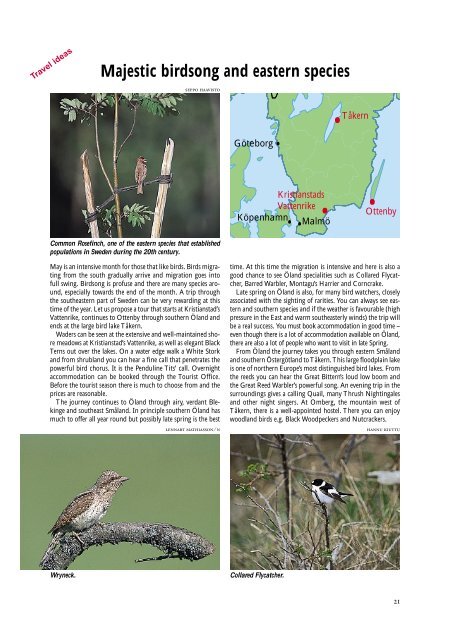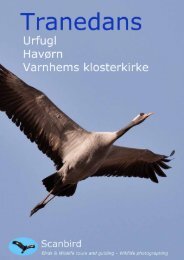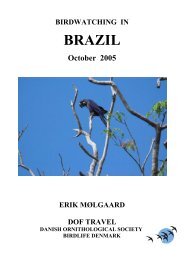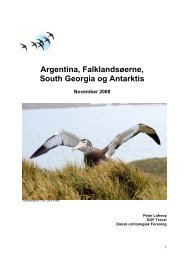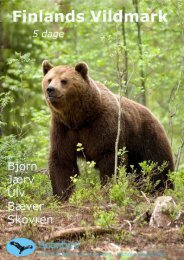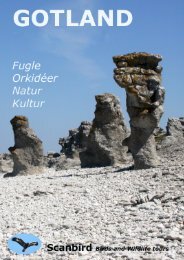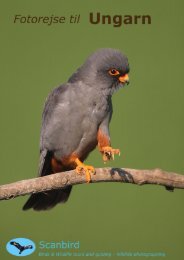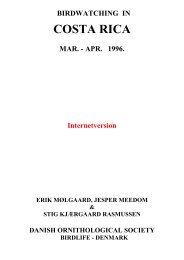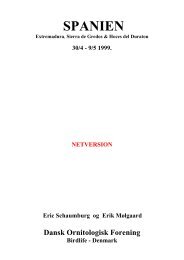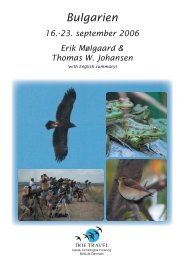Birding Southern Sweden (large PDF file (5 MB) - Tåkerns Fältstation
Birding Southern Sweden (large PDF file (5 MB) - Tåkerns Fältstation
Birding Southern Sweden (large PDF file (5 MB) - Tåkerns Fältstation
You also want an ePaper? Increase the reach of your titles
YUMPU automatically turns print PDFs into web optimized ePapers that Google loves.
Travel ideas<br />
Majestic birdsong and eastern species<br />
SEPPO HAAVISTO<br />
Göteborg •<br />
Tåkern<br />
•<br />
Kristianstads<br />
Vattenrike<br />
Köpenhamn Malmö<br />
• •<br />
• •<br />
Ottenby<br />
Common Rosefinch, one of the eastern species that established<br />
populations in <strong>Sweden</strong> during the 20th century.<br />
May is an intensive month for those that like birds. Birds migrating<br />
from the south gradually arrive and migration goes into<br />
full swing. Birdsong is profuse and there are many species around,<br />
especially towards the end of the month. A trip through<br />
the southeastern part of <strong>Sweden</strong> can be very rewarding at this<br />
time of the year. Let us propose a tour that starts at Kristianstad’s<br />
Vattenrike, continues to Ottenby through southern Öland and<br />
ends at the <strong>large</strong> bird lake Tåkern.<br />
Waders can be seen at the extensive and well-maintained shore<br />
meadows at Kristianstad’s Vattenrike, as well as elegant Black<br />
Terns out over the lakes. On a water edge walk a White Stork<br />
and from shrubland you can hear a fine call that penetrates the<br />
powerful bird chorus. It is the Penduline Tits’ call. Overnight<br />
accommodation can be booked through the Tourist Office.<br />
Before the tourist season there is much to choose from and the<br />
prices are reasonable.<br />
The journey continues to Öland through airy, verdant Blekinge<br />
and southeast Småland. In principle southern Öland has<br />
much to offer all year round but possibly late spring is the best<br />
LENNART MATHIASSON ⁄ N<br />
time. At this time the migration is intensive and here is also a<br />
good chance to see Öland specialities such as Collared Flycatcher,<br />
Barred Warbler, Montagu’s Harrier and Corncrake.<br />
Late spring on Öland is also, for many bird watchers, closely<br />
associated with the sighting of rarities. You can always see eastern<br />
and southern species and if the weather is favourable (high<br />
pressure in the East and warm southeasterly winds) the trip will<br />
be a real success. You must book accommodation in good time –<br />
even though there is a lot of accommodation available on Öland,<br />
there are also a lot of people who want to visit in late Spring.<br />
From Öland the journey takes you through eastern Småland<br />
and southern Östergötland to Tåkern. This <strong>large</strong> floodplain lake<br />
is one of northern Europe’s most distinguished bird lakes. From<br />
the reeds you can hear the Great Bittern’s loud low boom and<br />
the Great Reed Warbler’s powerful song. An evening trip in the<br />
surroundings gives a calling Quail, many Thrush Nightingales<br />
and other night singers. At Omberg, the mountain west of<br />
Tåkern, there is a well-appointed hostel. There you can enjoy<br />
woodland birds e.g. Black Woodpeckers and Nutcrackers.<br />
HANNU KIUTTU<br />
Wryneck.<br />
Collared Flycatcher.<br />
21


